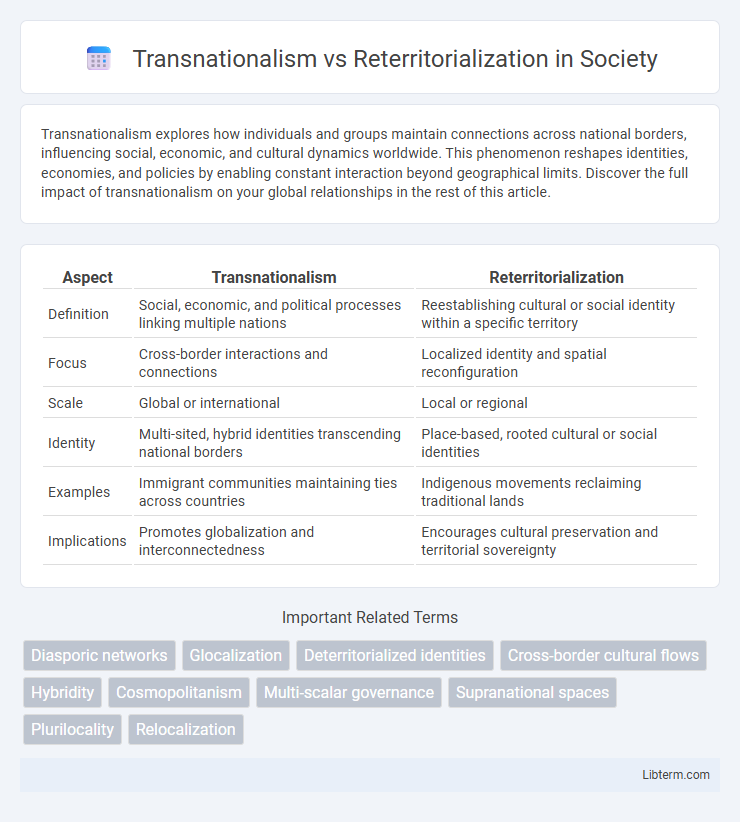Transnationalism explores how individuals and groups maintain connections across national borders, influencing social, economic, and cultural dynamics worldwide. This phenomenon reshapes identities, economies, and policies by enabling constant interaction beyond geographical limits. Discover the full impact of transnationalism on your global relationships in the rest of this article.
Table of Comparison
| Aspect | Transnationalism | Reterritorialization |
|---|---|---|
| Definition | Social, economic, and political processes linking multiple nations | Reestablishing cultural or social identity within a specific territory |
| Focus | Cross-border interactions and connections | Localized identity and spatial reconfiguration |
| Scale | Global or international | Local or regional |
| Identity | Multi-sited, hybrid identities transcending national borders | Place-based, rooted cultural or social identities |
| Examples | Immigrant communities maintaining ties across countries | Indigenous movements reclaiming traditional lands |
| Implications | Promotes globalization and interconnectedness | Encourages cultural preservation and territorial sovereignty |
Defining Transnationalism: Beyond National Borders
Transnationalism refers to the process by which individuals, groups, and institutions operate across national borders, creating social, economic, and political linkages that transcend traditional nation-state boundaries. It emphasizes the flow of people, ideas, capital, and culture between countries, fostering hybrid identities and networks that challenge territorially fixed notions of belonging. Unlike reterritorialization, which involves the reaffirmation of territorial control and localized identities, transnationalism promotes fluid connections that reshape global interactions beyond predefined geographic borders.
Understanding Reterritorialization: Reaffirming Boundaries
Reterritorialization involves the reaffirmation or restructuring of territorial boundaries in response to cultural, social, or political changes, emphasizing the significance of place-based identities and sovereignty. This process contrasts with transnationalism by reinforcing local or national borders rather than transcending them, often as a reaction to globalization or migration pressures. Scholars highlight reterritorialization as a mechanism through which communities reclaim control over space, reassert cultural norms, and resist deterritorializing forces.
Historical Context of Transnationalism
Transnationalism emerged prominently in the late 20th century as globalization intensified, facilitating sustained social, economic, and political ties across national borders. Historically, transnationalism challenges traditional notions of sovereignty by emphasizing the interconnectedness of migrant communities, multinational corporations, and international institutions. This paradigm contrasts with reterritorialization, which seeks to reinforce territorial boundaries and local identities in response to global flows.
Key Theories and Scholars in Reterritorialization
Reterritorialization is pivotal in postcolonial and cultural geography theories, emphasizing the reconfiguration of territorial identities and socioeconomic spaces disrupted by globalization. Key scholars such as Gilles Deleuze and Felix Guattari introduced the concept in their work "A Thousand Plateaus," highlighting it as the process by which deterritorialized elements acquire new territorial contexts, reshaping cultural and political boundaries. In contrast to Transnationalism, which focuses on flows across borders, Reterritorialization underscores the reconstruction and stabilization of space, identity, and power within specific geographic territories.
Socio-cultural Impacts of Transnationalism
Transnationalism fosters continuous social and cultural exchanges across national borders, leading to hybrid identities and diverse diasporic communities that reshape traditional notions of belonging and cultural norms. This dynamic process enhances multiculturalism, facilitates the flow of ideas, practices, and values, and supports the maintenance of heritage languages and traditions within immigrant populations. In contrast to reterritorialization, which emphasizes local territorial ties and fixed identities, transnationalism underscores fluid, cross-border linkages that transform socio-cultural landscapes globally.
Political Dimensions of Reterritorialization
Reterritorialization in political dimensions involves the reassertion of state sovereignty and control over territories in response to globalization and transnational pressures, often leading to strengthened border policies and localized governance. It challenges transnationalism by emphasizing national identity, legal jurisdictions, and territorial integrity as mechanisms to regulate cross-border flows of people, capital, and information. These political processes underscore the tension between global interconnectedness and the reaffirmation of territorial boundaries to maintain political authority and cultural coherence.
Case Studies: Migration and Diaspora Networks
Migration and diaspora networks exemplify transnationalism by maintaining cross-border social, economic, and political ties that transcend state boundaries, fostering global interconnectedness. In contrast, reterritorialization emphasizes the reassertion of local identities and cultural practices within specific geographic spaces, often as a response to global migration pressures. Case studies of diaspora communities in cities like New York and London reveal how migrants negotiate dual attachments, simultaneously engaging in transnational networks while reinforcing localized territorial claims.
Economic Intersections: Globalization at Play
Transnationalism reshapes economic intersections by facilitating cross-border flows of capital, labor, and information, driving globalization through decentralized financial networks and multinational corporations. Reterritorialization reinforces localized economic control by adapting global influences to specific regional markets, emphasizing place-based production and consumption patterns. The dynamic interplay between transnational economic integration and reterritorialized market adaptations defines contemporary globalization's complex spatial and economic landscape.
Challenges and Critiques of Both Concepts
Transnationalism faces challenges related to maintaining strong cultural identities while navigating multiple national boundaries, causing tensions in political loyalty and social integration. Reterritorialization is critiqued for potentially reinforcing state control and limiting the fluidity of global cultural exchanges by reasserting geographic boundaries. Both concepts highlight the complex interplay between globalization and local identities, raising debates over power dynamics, cultural preservation, and mobility restrictions.
Future Perspectives: Transnationalism and Reterritorialization in a Digital Age
Future perspectives on transnationalism and reterritorialization in the digital age emphasize the evolving dynamics of identity, sovereignty, and connectivity shaped by advanced communication technologies. Digital platforms facilitate transnational networks that transcend physical borders, simultaneously prompting new forms of reterritorialization where virtual spaces become critical loci of cultural and political organization. This interplay influences governance, economic exchanges, and social interactions, underscoring the necessity for adaptive policies that address the fluidity of digital transnationalism and the reemergence of territorial attachments in cyberspace.
Transnationalism Infographic

 libterm.com
libterm.com